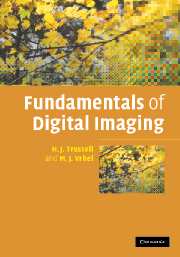Book contents
- Frontmatter
- Contents
- Preface
- Acknowledgments
- 1 Introduction
- 2 Mathematical representation
- 3 Elementary display of images
- 4 Quantization
- 5 Frequency domain representation
- 6 Spatial sampling
- 7 Image characteristics
- 8 Photometry and colorimetry
- 9 Color sampling
- 10 Image input devices
- 11 Image output devices and methods
- 12 Characterization of devices
- 13 Estimation of image model parameters
- 14 Image restoration
- A Generalized functions and sampling representation
- B Digital image manipulation and matrix representation
- C Stochastic images
- D Multidimensional look-up tables
- E Psychovisual properties
- References
- Index
E - Psychovisual properties
Published online by Cambridge University Press: 06 July 2010
- Frontmatter
- Contents
- Preface
- Acknowledgments
- 1 Introduction
- 2 Mathematical representation
- 3 Elementary display of images
- 4 Quantization
- 5 Frequency domain representation
- 6 Spatial sampling
- 7 Image characteristics
- 8 Photometry and colorimetry
- 9 Color sampling
- 10 Image input devices
- 11 Image output devices and methods
- 12 Characterization of devices
- 13 Estimation of image model parameters
- 14 Image restoration
- A Generalized functions and sampling representation
- B Digital image manipulation and matrix representation
- C Stochastic images
- D Multidimensional look-up tables
- E Psychovisual properties
- References
- Index
Summary
In many cases, the human observer is the final judge of the quality of a recorded and reproduced image. The perceived quality is dependent upon the expectations and needs of the viewer, as well as the properties of the human visual system (HVS). Algorithms and devices should be designed using knowledge of the limitations of the human visual system. Such algorithms and devices typically run faster, use less bandwidth and cost less than a device designed with little thought regarding the human observer. In this appendix, we will review many of the characteristics of the human visual system that are useful when designing algorithms and devices for image recording and reproduction. For an in-depth look at this topic see [300].
The human visual system is a highly nonlinear, adaptive system making it very difficult to model completely. As with most systems, linear models can offer a level of approximation that is sufficiently close and significantly more tractable. One approach to model the human visual system is to divide it into a number of subsystems. One such division is given by:
Optical elements, including lens and pupil aperture,
Sensing elements, consisting of cones and rods,
Processing elements, consisting of interconnected neurons in the eye and the visual cortex.
Information
- Type
- Chapter
- Information
- Fundamentals of Digital Imaging , pp. 499 - 511Publisher: Cambridge University PressPrint publication year: 2008
